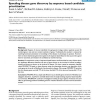Free Online Productivity Tools
i2Speak
i2Symbol
i2OCR
iTex2Img
iWeb2Print
iWeb2Shot
i2Type
iPdf2Split
iPdf2Merge
i2Bopomofo
i2Arabic
i2Style
i2Image
i2PDF
iLatex2Rtf
Sci2ools
BMCBI
2005
2005
Speeding disease gene discovery by sequence based candidate prioritization
Background: Regions of interest identified through genetic linkage studies regularly exceed 30 centimorgans in size and can contain hundreds of genes. Traditionally this number is reduced by matching functional annotation to knowledge of the disease or phenotype in question. However, here we show that disease genes share patterns of sequence-based features that can provide a good basis for automatic prioritization of candidates by machine learning. Results: We examined a variety of sequence-based features and found that for many of them there are significant differences between the sets of genes known to be involved in human hereditary disease and those not known to be involved in disease. We have created an automatic classifier called PROSPECTR based on those features using the alternating decision tree algorithm which ranks genes in the order of likelihood of involvement in disease. On average, PROSPECTR enriches lists for disease genes two-fold 77% of the time, five-fold 37% of the...
| Added | 15 Dec 2010 |
| Updated | 15 Dec 2010 |
| Type | Journal |
| Year | 2005 |
| Where | BMCBI |
| Authors | Euan A. Adie, Richard R. Adams, Kathryn L. Evans, David J. Porteous, Ben S. Pickard |
Comments (0)

